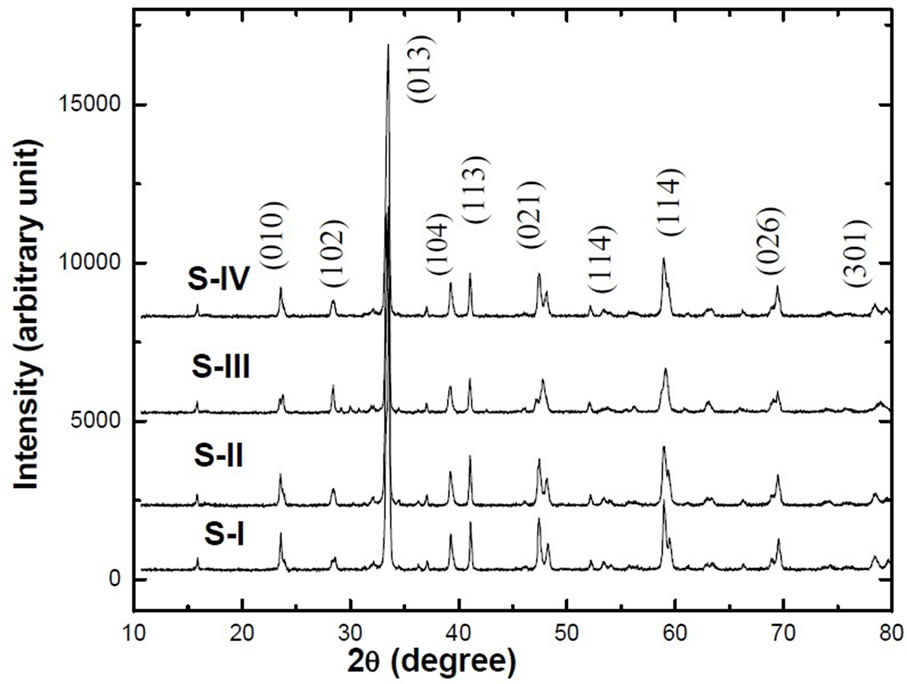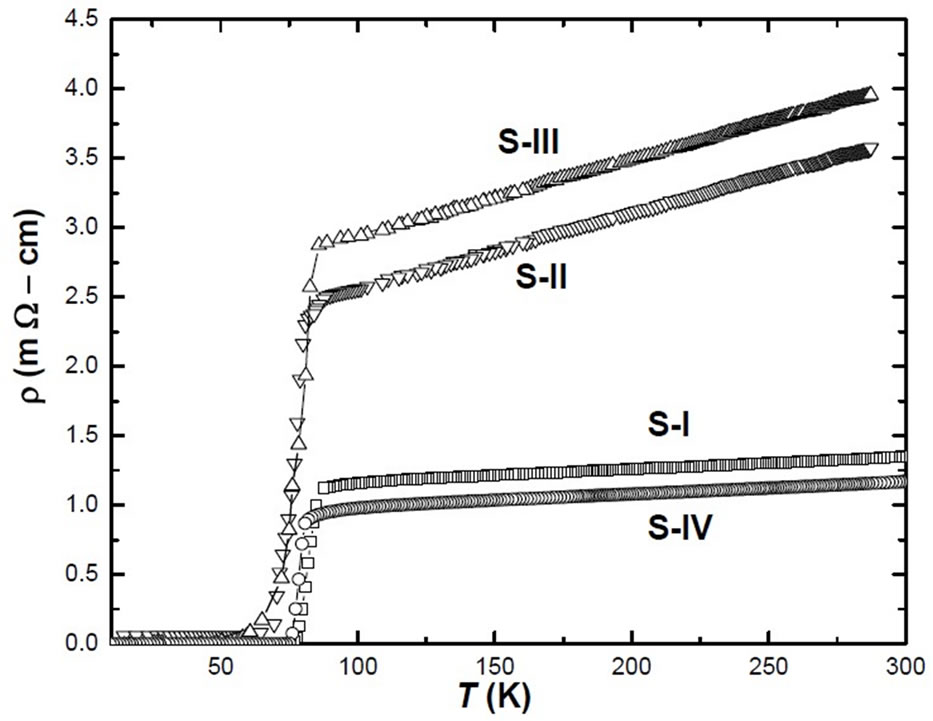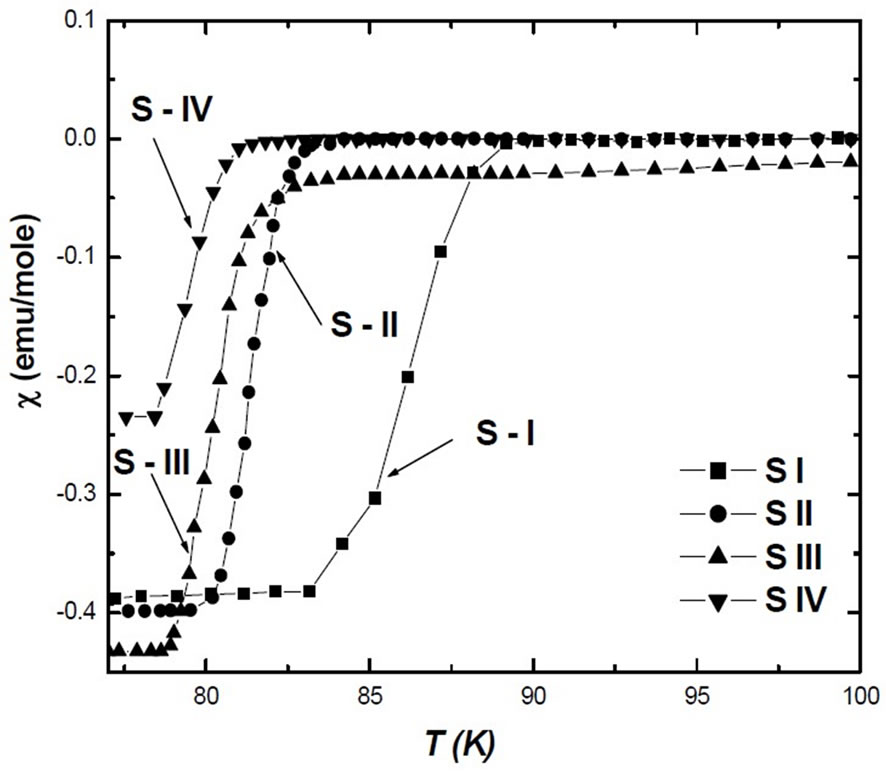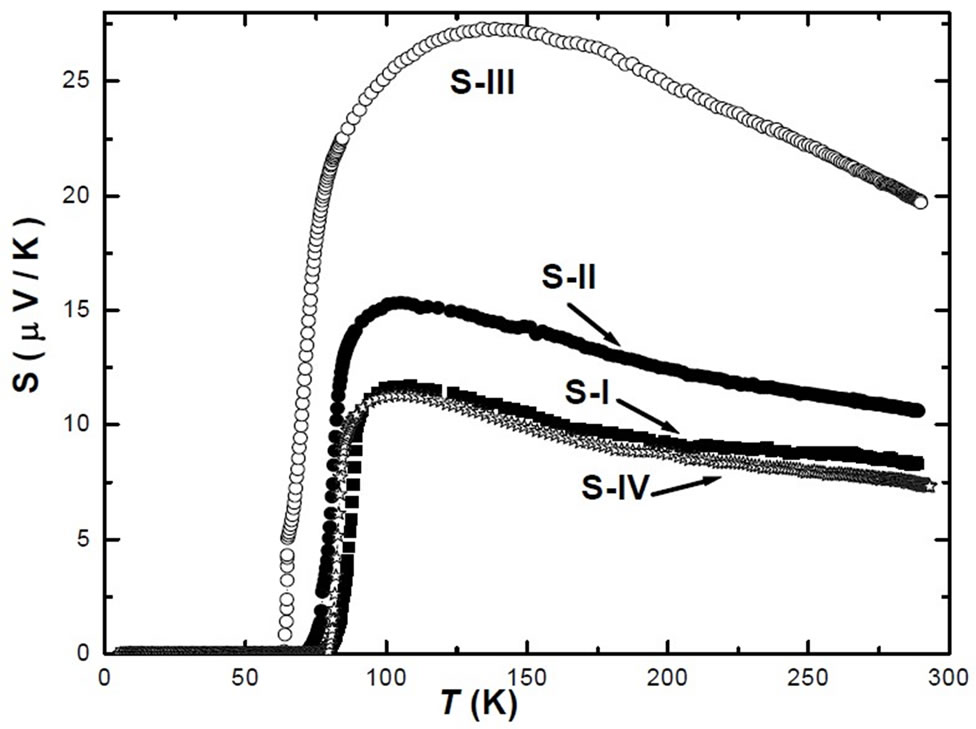Journal of Modern Physics
Vol. 2 No. 8 (2011) , Article ID: 6819 , 6 pages DOI:10.4236/jmp.2011.28109
Alkaline Earth (Ca) and Transition Metal (Ni) Doping on the Transport Properties of Y1-xCaxBa2(Cu1-yNiy)3O7- Superconductors
1School of Physics, Vigyan Bhavan, Khandwa Road Campus, Devi Ahilya University, Indore, India
2School of Instrumentation, USIC Bhavan, Khandwa Road Campus, Devi Ahilya University, Indore, India
E-mail: vdinesh33@rediffmail.com, vdinesh33@gmail.com
Received March 10, 2011; revised April 27, 2011; accepted May 18, 2011
Keywords: Y-Based Superconductors, Doping Effect, Transport Properties
ABSTRACT
We report the results of dc resistivity, ac susceptibility, and thermopower study of partial substitution at Y (A site by Ca) and at Cu (B site by Ni) polycrystalline superconductors. The iodometric analysis reveals that the oxygen deficiency, d, for YBa2Cu3O7-d (S-I), Y0.9Ca0.1 Ba2Cu3O7-d (S-II), Y0.8Ca0.2Ba2Cu3O7-d (S-III) and Y0.9Ca0.1 Ba2(Cu0.99Ni0.01)3O7-d (S-IV) samples are 0.16, 0.30, 0.39 and 0.29 respectively. The x-ray powder diffraction pattern indicates that all samples are in orthorhombic phase. The dc resistivity, ac susceptiblity and the thermopower measurements shows that the divalent Calcium doping at the trivalent Y site and transition metal Ni doping at Cu site causes a suppression of the superconducting transition temperature (Tc) from 89 to 81 K. The ac susceptibility confirms the ferromagnetic to antiferromagnetic phases at a defined Tc. The room temperature S value increases for Ca substituted YBa2Cu3O7-d while to that it decreases for Y0.9Ca0.1Ba2(Cu0.99Ni0.01)3O6.71. The above feature is an indicative of enhanced number of mobile holes for the Ca doped YBa2Cu3O7-d, while to that the charge carrier density is reduced in simultaneous A (Ca) and B (Ni) site doped sample.
1. Introduction
Both alkaline earth and transition metal substitutions in cuprate superconductors are important for the phenomenon of superconductivity. The presence of magnetic impurities with variable concentration of carriers can cause changes of transport and electronic properties of the bulk system. All cuprate superconductors transformed from anti-ferromagnetic insulators to superconductors, and then to metals for enhanced doping. Thus the substitutional effects in the host compounds provides key insights into the electronic properties, phases, active phonon modes and symmetry of high-Tc superconductivity and has been a major focus of high-Tc research in superconductors, since its discovery [1].
The YB2Cu3O7-d (YBCO) is an ideal superconductor and much research activities are focused mainly to investigate substitutional effects at Y (A) [2-5] site. The partial substitution of Y3+ by Ca2+ in YBCO changes the carrier concentration and influences the charge transfer from the Cu-O chains to the conducting CuO2 layers. Ideally, the Oxygen induces superconductivity in Ca-free YBCO while Ca does similarly in oxygen-deficient YBCO. The optimal value for oxygen doping of YBCO is for d = 6.92 with a Tc of about 90 K. The substitution of alkaline earth metals at A site suppresses the superconducting Tc from 90 to 80 K and has been a subject of immense importance.
On the other hand, the presence of transition metal impurities at Cu site (B) in YBa2Cu3O7-d cuprates as well increased oxygen deficiency further suppresses the transition temperature (Tc) [6-11]. Less attention has been paid on simultaneous partial substitution of divalent alkaline earth at Y site (A) and transition metal impurity at Cu site. It is now established that high-Tc cuprates as YBa2Cu3O7-d show a large number of interesting features that includes antiferromagnetic, pseudogap, marginal Fermi liquid and ordinary Fermi liquid phases in addition to the superconducting phase, apart from the changes in the superconducting transition temperature Tc [12,13]. It is worth to comment that A and B site doping in YBa2Cu3O7-d superconductors will lead to an understanding of the effects of pair breaking, local moments, hole doping, ion size effects and disorder on the superconducting condensate.
The transport measurements as dc electrical resistivity and thermopower are powerful probes to investigate the electronic states and phases of the host as well of the partially substituted YBCO either at A or at B site. It is inferred from the resistivity measurements that with the enhanced Ca doping at Y site, the resistivity of the samples decreases significantly [3,4]. Furthermore, Ni atoms substituted for Cu in YBa2Cu3O7-d the resistivity for minimal doping decreases as compared to the parent compound, while to that for enhanced doping (50%) the resistivity increases [7]. Substitution of Cu with metallic elements should produce substantial changes in the superconducting Tc, which is also reflected in the transport properties. It is worth to mention that no systematic effort has been made to study the simultaneous substitutional effects in YBa2Cu3O7-d with both A and B site doping.
The thermopower measurement is a technique that gives information about charge carriers. The YB2Cu3O7-d superconductor contains both two-dimensional CuO2 planes and one-dimensional CuO chains. We may refer to the work of Bernhard and Tallon [14], who investigated the thermopower of polycrystalline Y1-xCaxB2Cu3O7-d [0 ≤ x ≤ 0.2 and 0.04 ≤ d ≤ 0.98]. The partial substitution introduces additional hole carriers into the CuO2 planes and makes the YBCO system access far into the overdoped regime [15]. The measured thermopower decreases almost linearly with temperature and a room temperature value of S ~ 1 - 2 mV/K is documented and is argued for the CuO2 plane contribution. We must mention that no result has been documented in the literature about thermopower for Ni doping at Cu site in YBa2Cu3O7-d superconductors. Henceforth, it is the purpose of the present paper to investigate the effect of transport properties on the simultaneous substitutional effects in YB2Cu3O7-d superconductors.
The ion size effects and disorder on the superconducting state are substantial in YBCO superconductors and with these motivations, we aimed at the understanding of transport properties of both A [divalent Ca (4s2) at the trivalent Y (4d15s2)] and B [Ni (3d84s2) at the Cu (3d104s1)] site substitutions in Y1-xCaxBa2Cu3O7-d (YCBCO) and Y1-x CaxBa2Cu3-yNiyO7-d (YCBCNO) superconductors. We must mention that the individual effects have been reported earlier in the literature but a simultaneous effect of the Ca substitution and Ni doping has not been investigated. We perform the dc resistivity, ac susceptibility, and thermopower measurements of YBa2Cu3O7-d (S-I), Y0.9Ca0.1Ba2Cu3O7-d (S-II), Y0.8Ca0.2Ba2Cu3O7-d (S-III) and Y0.9Ca0.1Ba2 (Cu0.99Ni0.01)3O7-d (S-IV) superconductors to delineate the substitutional effects both at A and B sites.
2. Experimental Details
Polycrystalline samples of YB2Cu3O7-d (YBCO), Y1-xCaxBa2Cu3O7-d (YCBCO) and Y1-x CaxBa2Cu3-y
NiyO7-d (YCBCNO) [S-I – S-IV] were prepared for the experiments conducted by the solid-state ceramic route [16]. Powders of Y2O3, BaCO3, CaCO3, Fe2O3, and NiO in the stoichiometric ratios were mixed and annealing at temperatures (850˚C, 900˚C) for 24 hours with intermediate grindings. The pellets were annealed at 950˚C for 48 h in Oxygen atmosphere. The samples are cooled in oxygen at the rate of 5 to 10 C per minute. A slow with preferably a long anneals enable to have a proper stoichiometry. The x-ray diffraction (XRD) measurements were carried out with Cu Kα radiation using a Rigaku powder diffractometer equipped with a rotating anode scanning (0.01 step in 2q) over the angular range 10˚ - 80˚ at room temperature generating x-ray by 40 kV and 100 mA power settings. For finding oxygen content we perform the improved iodometric titration reported [17].
The dc resistivity and thermo power measurements of all prepared samples (SI-SIV) have been done to 10 - 300 K. The dc resistivity measurements using four-probe method. Indium contacts are made on the polished surface of the sample. The sample is in the form of a rectangular rod. The SI temperature controller, Schlumberger multimeter and Advantest current source is used for the measurement. A vacuum of the order of 10-5 mbar was maintained in the chamber with the help of turbo molecular pump assembly with silicon diode as the sensor. The ac susceptibility measurements were carried out using home made setup [18]. In the critical region, the temperature was controlled to an accuracy of 0.01 K using commercial Lakeshore controllers DRC93CA and 340.
3. Results and Discussion
The XRD patterns of YBa2Cu3O6.84 (S-I), Y0.90Ca0.10Ba2Cu3O6.7 (S-II), Y0.80Ca0.20Ba2Cu3O6.61 (S-III) and Y0.9Ca0.1Ba2(Cu0.99 Ni0.01)3O6.71 (S-IV) are shown in Figure 1. These are indexed in the orthorhombic phase and the deduced lattice parameters are illustrated in Table 1. The above lattice parameters are consistent with the earlier reports and corresponds to space group Pmmm [3,7]. It is inferred that the cell volume increases as Ca doping is partially enhanced at Y site, it further decreases for Ni doping at Cu site. The oxygen content in prepared samples is determined by the improved iodometric titration method [17]. We find the value of d = 0.16, 0.30,

Table 1. Lattice parameters, cell volume and oxygen content of YBCO superconductors.

Figure 1. The x-ray diffraction pattern for samples S-I (YBa2Cu3O6.84), S-II (Y0.90Ca0.10Ba2Cu3O70), S-III (Y0.80Ca0.20Ba2Cu3O6.61) and S-IV (Y0.9Ca0.1Ba2(Cu0.99 Ni0.01)3O6.71).
0.39 and 0.29 for S-I to S-IV, respectively. We note the prepared polycrystalline samples are single phase and the oxygen content as determined from the Iodometric analysis is consistent with the earlier findings [3].
The experimental data for dc resistivity of all these samples are illustrated in Figure 2. The superconducting transition temperature Tc of samples S-I to S-IV is documented in Table 2. It is noticed that the Tc decreases with the increased Ca doping at Y site and further decreases with the substitution of Ni at Cu site. The above is attributed to the fact that the substitution of Ca2+ for Y3+ in YB2Cu3O7-d (YBCO) generates holes. The Ca substitution at Y site leads to counteract the hole-filling effect of oxygen vacancies, and the result is a significant increase in conducting hole concentration. The measured values of transition temperature Tc are comparable to the reported data [14] for parent as well as Ca and Ni doping. Furthermore, above Tc, we have observed metallic behavior for all prepared superconductor samples. It is argued that in Y0.9Ca0.1Ba2(Cu0.99 Ni0.01)3O6.71 the transition metal ions (Ni) are distributed nearly equal between Cu (1) chain and Cu (2) plane sites [11]. The transition metal Ni ions act as hole filling agent and hence shows sharp transition at superconducting state with minimum oxygen deficiency as compared to the parent YB2Cu3O7-d superconductor. Later on, the ac susceptibility measurements of these samples were carried out to confirm the superconducting Tc as shown in Figure 3. It is noticed that all the samples S-I to S-IV superconductors undergo a transition from paramagnetic to diamagnetic phase at a defined Tc. The Tc values were determined from the inflexion points of the c (T) curves consistent with the previous measurements [3].
The results of thermopower (S) measurements for S-I to S-IV are shown in Figure 4. The value of S at room temperature is found to be positive for all the samples, indicating them to be predominantly hole-type conductors. The measured values of thermopower at room temperature for samples S-I-S-IV are 8.3, 10.6, 19.6 and 7.3 m V K–1, respectively. These values are consistent with the previously reported values [14]. It is inferred that the value of thermopower at room temperature increases monotonically with increasing Ca x for first three samples, implying that the number of mobile hole as carrier increases with increasing x in the Y1-xCaxBa2Cu3O7-d superconductor. The result for Y0.9Ca0.1Ba2(Cu0.99 Ni0.01)3O6.71 superconductor could not be compared due to lack of data.
4. Conclusions
The present investigations explore the effect of doping

Figure 2. Variation of dc resistivity as a function of temperature for samples S-I - S-IV.

Figure 3. The ac susceptibility behavior with temperature for samples S-I - S-IV.

Table 2. Transition temperature Tc, oxygen content (d) and resistivity r values as r (300 K) and r (Tc) for YBCO superconductors along with previous measurements [14].
[non magnetic Ca substitution at Y site and transition metal Ni at Cu site in YBa2Cu3O7-d superconductors] on the structural, electrical, and magnetic properties. The x-ray diffraction patterns of all samples were indexed in the orthorhombic phase with space group Pmmm. All the samples were found to be monophasic without any trace of impurity like BaCuO3 or related phases. The cell volume increases as Ca doping increases at Y site, it further decreases for Ni doping at Cu site. Resistivity and susceptiblity data shows the Tc at 89, 83, 82 and 81 K for S-I - S-IV samples, respectively. Divalent Calcium (Ca) doping at the trivalent (Y) site and transition metal Ni doping at Cu site causes a suppression of the superconducting transition temperature (Tc) from 89 to 81 K.
Above Tc, the resistivity data for all samples shows metallic behaviour but as Ca doping at Y site (S-II)

Figure 4. Variation of thermopower as function of temperature (S) for samples S-I - S-IV.
compare to parent sample (S-I), the magnitude residual resistivity is larger and if further increase the doping of Ca concentration at Y site (S-III), then it also increases. The B site Ni doping (S-IV) at Cu, a metallic characteristic is noticed but residual resistivity decreases as compare to the parent sample (S-I). The ac susceptibility measurements show a transition from ferromagnetic to antiferromagnetic phase at the well-defined Tc. The room temperature thermopower value increases with increased doping [S-I – S-III] while it decreases for simultaneous doping at A and B site [S-IV], indicating an enhanced number of mobile holes for first three samples and reduced charge carrier for A and B site doped S-IV sample.
5. Acknowledgements
Financial assistance from UGC, Delhi is gratefully acknowledged. Authors are thankful to UGC-DAE-CSR, Indore for providing facilities. We acknowledge Dr. V. Ganeshan, Dr. R. Rawat, Dr. R. J. Choudhary and Dr. V. Sathe for their support in carrying out measurements.
REFERENCES
- J. G. Bednorz and K. A. Muller, “Possible highTc Superconductivity in the Ba-La-Cu-O System,” Zeitschrift für Physik B, Vol. 64, No. 2, 1986, pp. 189- 193.
- W Guan, J. C. Chen and S. H. Cheng, “Ion-Size Effect on Transport Properties in R0.9Ca0.1Ba2Cu3O7-δ Systems (R = Tm, Ho, Gd, and Nd),” Physical Review B, Vol. 54, No. 5, 1996, pp. 3580-3588. doi:10.1103/PhysRevB.54.3580
- V. P. S. Awana, A. Tulapurkar, S. K. Mallik and A. V. Narlikar, “Role of Ca in Enhancing the Superconductivity of YBa2Cu3O7-y,” Physical Review B, Vol. 50, No. 1, 1994, pp. 594-596. doi:10.1103/PhysRevB.50.594
- B. Fisher, J. Genossar, C. G. Kuper, L. Patlagan, G. M. Reisner and A. Knizhnik, “Effects of Substituting Calcium for Yttrium on the Properties of YBa2Cu3O7-δ,” Physical Review B, Vol. 47, No. 10, 1993, pp. 6054-6059. doi:10.1103/PhysRevB.47.6054
- R. J. Tellon and L. F. Flower, “Stoichiometric YBa2Cu3O7 is Overdoped,” Physica C, Vol. 204, No. 3-4, 1993, pp. 237-246. doi:10.1016/0921-4534(93)91005-G
- G. Xiao, F. H. Streitz, A. Gavrin, Y. W. Du and C. L. Chien, “Effect of Transition-Metal Elements on the Superconductivity of Y-Ba-Cu-O,” Physical Review B, Vol. 35, No. 16, 1987, pp. 8782-8784. doi:10.1103/PhysRevB.35.8782
- J. M. Tarascon, P. Barboux, P. F. Miceli, L. H. Greene and G. H. Hull, “Structural and Physical Properties of the Metal (M) Substituted YBa2Cu3-xMxO7-y Perovskite,” Physical Review B, Vol. 37, No. 13, 1988, pp. 7458-7469. doi:10.1103/PhysRevB.37.7458
- R. L. Neiman, J. Giapintzakis and D. M. Ginsberg, “Transition Temperature and Irreversibility Line of Cobalt-Doped Single-Crystal YBa2Cu3O7-δ: The Effect of High-Pressure Oxygen Annealing,” Physical Review B, Vol. 50, 1994, pp. 16028-16032. doi:10.1103/PhysRevB.50.16028
- J. T. Kim, J. Giapintzakis and D. M. Ginsberg, “Sign Reversal of the Hall Effect in Superconducting YBa2 (Cu1-xNix)3O7-δ Single Crystals,” Physical Review B, Vol. 53, No. 9, 1996, pp. 5922-5826. doi:10.1103/PhysRevB.53.5922
- E. R. Ulm and T. R. Lemberger, “Sign Reversal of the Hall Effect in Superconducting YBa2(Cu1-xNix)3O7-δ Single Crystals,” Physical Review B, Vol. 53, No. 9, 1996, pp. 11352-11355. doi:10.1103/PhysRevB.53.11352
- B. D. Padalia, S. J. Gurman, P. K. Mehta and O. Prakash, “Extended X-Ray Absorption Fine-Structure Studies of 3d Ions in YBa2(Cu1-xMx)3O7 – delta (x < or = 0.10; M Identical to Mn, Fe, Co, Ni and Zn),” Journal of Physics: Condensed Matter, Vol. 4, No. 33, 1992, p. 6865. doi:10.1088/0953-8984/4/33/001
- M. A. Kastner, R. J. Birgeneau, G. Shirane and Y. Endoh, “Magnetic, Transport, and Optical Properties of Monolayer Copper Oxides,” Reviews of Modern Physics, Vol. 70, No. 3, 1998, pp. 897-928;
- T. Timusk and B. Statt, “The Pseudogap in High-Temperature Superconductors: An Experimental Survey,” Reports on Progress in Physics, Vol. 62, No.1, 1999, pp. 61- 122.
- C. Bernhard and J. L. Tallon, “Thermoelectric Power of Y1-xCaxBa2Cu3O7-δ: Contributions from CuO2 Planes and CuO Chains,” Physical Review B, Vol. 54, No. 13, 1996, pp. 10201-10209. doi:10.1103/PhysRevB.54.10201
- J. R. Cooper and J. W. Loram, “Some Correlations between the Thermodynamic and Transport Properties of High Tc Oxides in the Normal State,” Journal de Physique I France, Vol. 6, No. 12, 1996, pp. 2237-2263.
- D. Varshney, I. Mansuri and N. Kaurav, “Effect of Electron/Hole Doping on the Transport Properties of Lanthanum Manganites LaMnO3,” Journal of Physics: Condensed Matter, Vol. 19, No. 24, 2007, p. 246211. doi:10.1088/0953-8984/19/24/246211
- W. M. Chen, C. C. Lam, J. F. Geng, L. Y. Li, K. C. Hung and X. Jin, “A New Calculating Formula of Iodometric Titration For High Tc Superconductors,” Physica C, Vol. 270, No. 1-2, 1996, pp. 155-158. doi:10.1016/0921-4534(96)00497-2
- R. V. Krishnan and A. Banerjee, “Harmonic Detection of Multipole Moments and Absolute Calibration in a Simple, Low-Cost Vibrating Sample Magnetometer,” Review of Scientific Instruments, Vol. 70, No. 1, 1999, pp. 85-91. doi:10.1063/1.1149545

